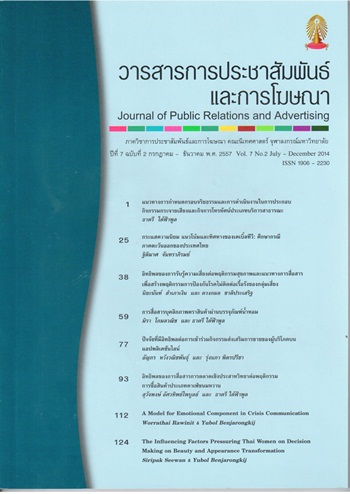A MODEL FOR EMOTIONAL COMPONENT IN CRISIS COMMUNICATION
Main Article Content
Abstract
This research aims to study the effect of emotions on stakeholders’ response to different types of crises and on success of organizations/related agencies’ crisis communication. It also aims to create a model demonstrating emotional elements of crisis communication. The researcher studied 3 crises as the case studies, which are the massive flood in year 2011, the explosion and conflagration in the factory of BST Elastromer, Co., Ltd. in Map Ta Phut Industrial Estate, and the strike of employees of State Railway of Thailand. The research methodology combines between qualitative research, which includes document study, in-depth interview, and quantitative research, which includes a questionnaire to collect data from 1,208 samples who are stakeholders in each type of crisis. The statistical data processing is done by factor analysis and multiple regression methods.
The results found that the most obvious emotions of stakeholders during (1) the massive flood in year 2011 were anxiety, fear, and sadness. The appearing emotions were the clear combination of both positive and negative emotions. They comprised a group of Negative Emotion – Severe Effect (EMO1), a group of Negative Emotion – Non-Severe Effect (EMO2), a group of Positive Emotion – Challenge of Life (EMO3), and a group of Positive Emotion – Optimism (EMO4). The most obvious emotions of stakeholders during (2) the explosion in BSTE’s factory were fear, anxiety and sorrow. The appearing emotions comprised 3 groups, which were a group of Negative Emotion – Loss of Confidence in the organization (EMO1), a group of Negative Emotion – Unconfident about the Situation (EMO2), and a group of Positive Emotion – Optimism (EMO3). The most obvious emotions of stakeholders during (3) the strike of employees of State Railway of Thailand were boredom, shame, frustration. The appearing emotions were the both positive and negative emotions, which were a group of Negative Emotion – Organization fails to meet Standards (EMO1), a group of Negative Emotion – Combination with Curiosity and Eager to try (EMO2), a group of Negative Emotion – Perplexing and Worried (EMO3), and a group of Positive Emotion – Situation bring about Change (EMO4). In addition, it is also found that the expressed emotion is related to the evaluation of communication success in the crisis of stakeholders. Although the relationship is minimal, but it shows that the emotion of stakeholders affects the success of communication in the crisis.


